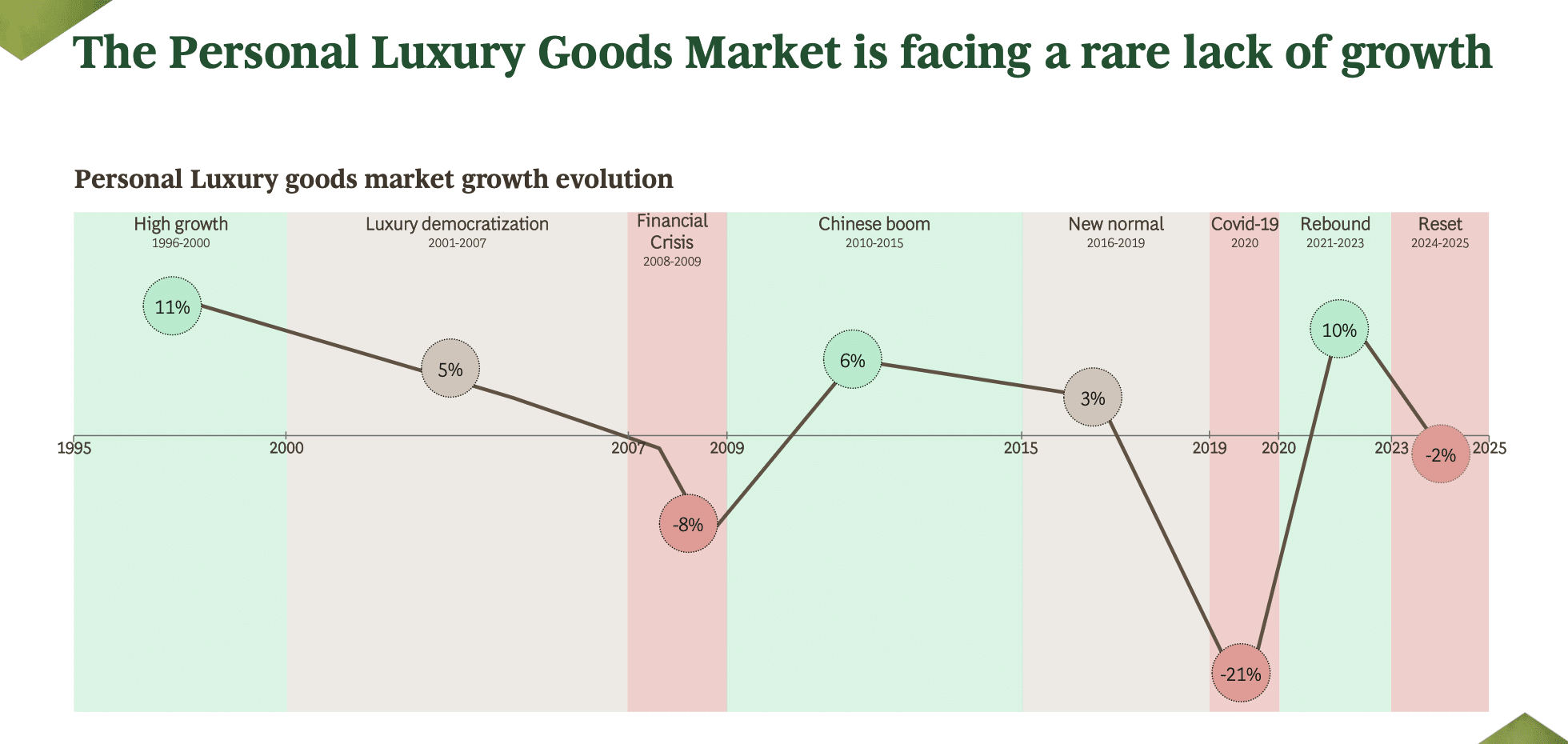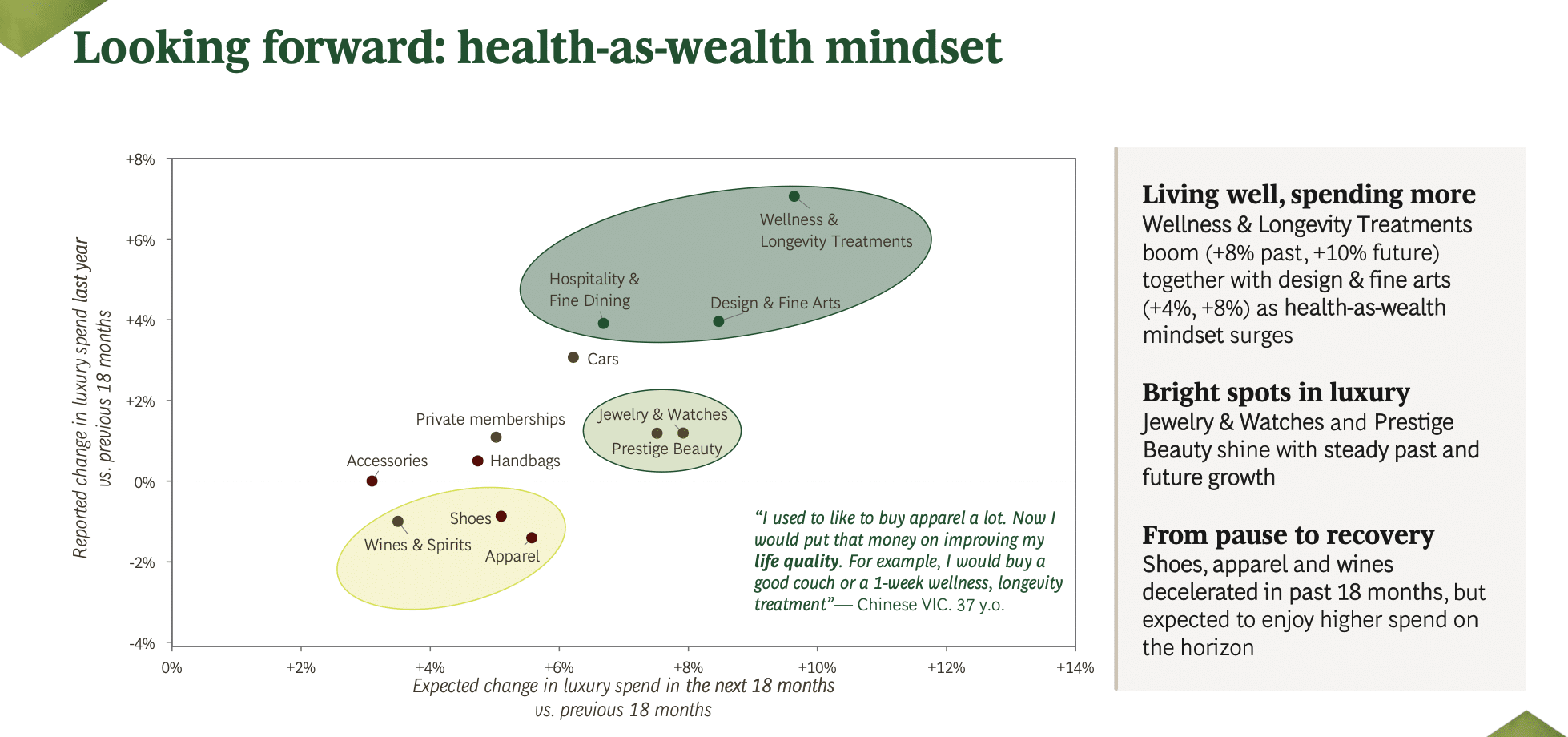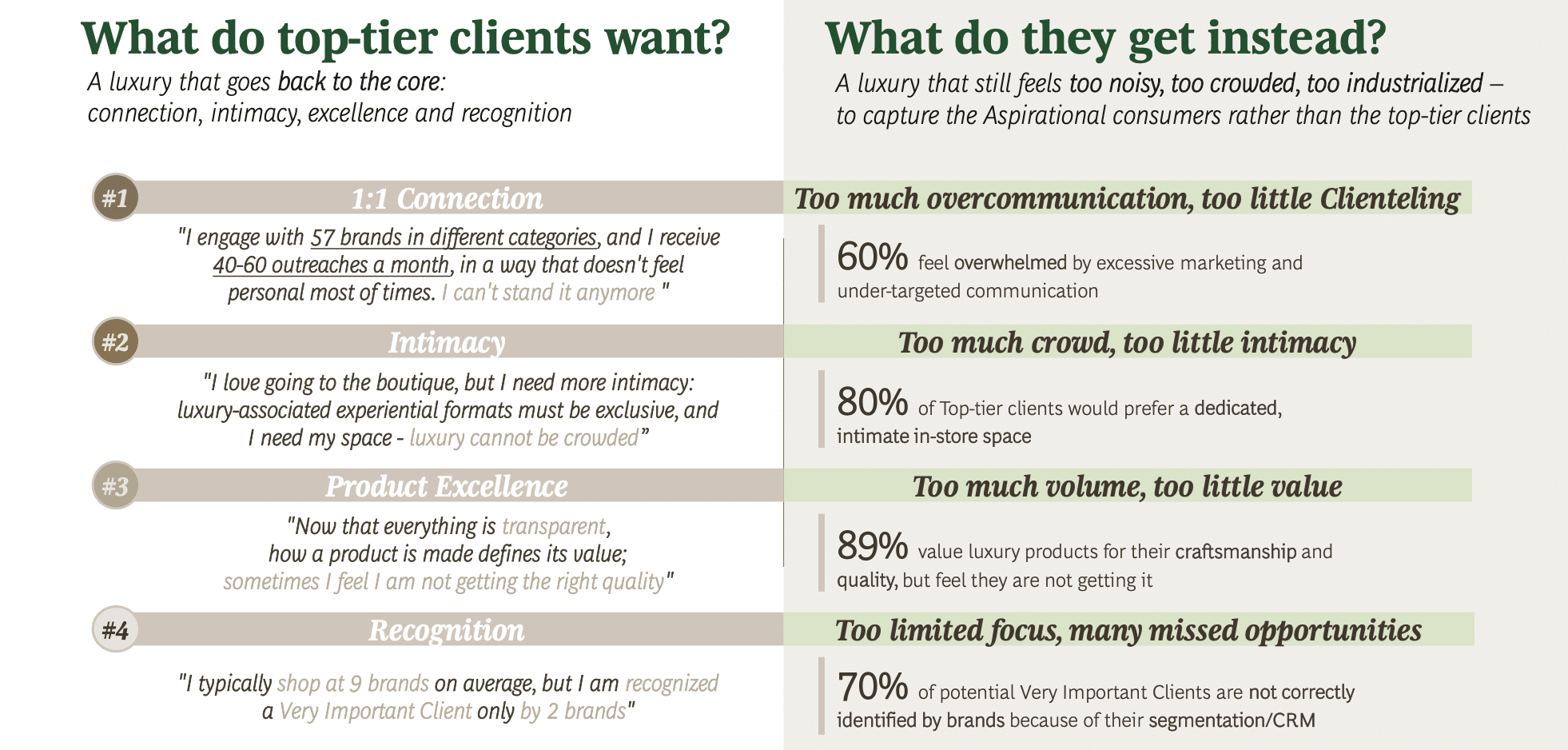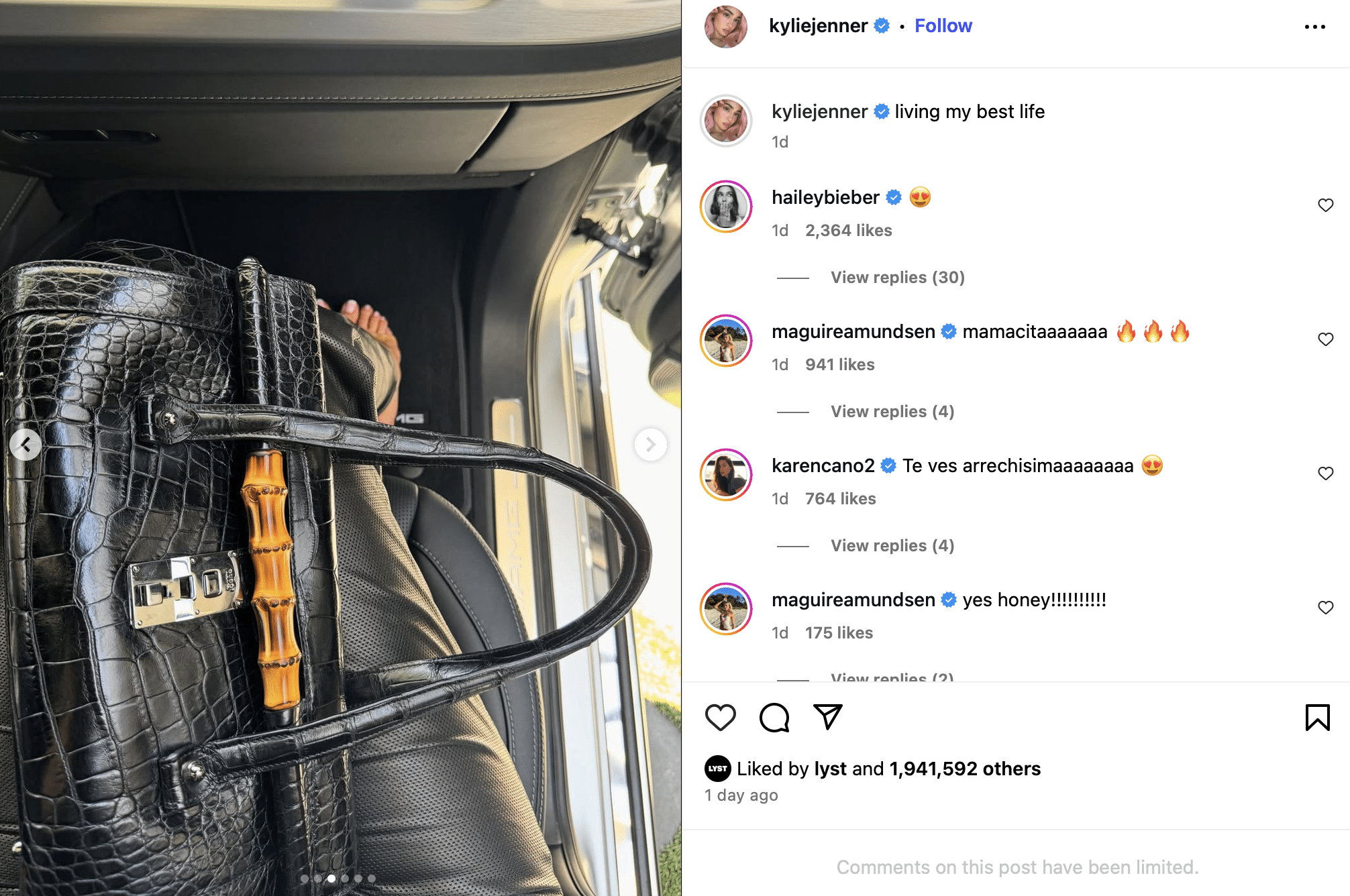BCG and Altagamma recently released their 11th annual “True-Luxury Global Consumer Insights” report, offering a sharp diagnostic of the shifting luxury landscape. In a year marked by economic headwinds and fading aspirational demand, the report draws on data from 7,000 global consumers, top-tier VIC interviews, and Altrata’s Wealth-X database to spotlight where growth remains: the ultra-affluent.
The study urges brands to pivot decisively: refocus on product excellence, elevate personalization through AI-enabled clienteling, and rebuild intimacy and recognition for the wealthiest consumers who are driving the industry’s future. With democratization in retreat, luxury’s next chapter hinges on exclusivity, experience, and a return to the core. Here are the top-line areas of the report to review …

1. Top-Tier Clients Are the New Power Center of Luxury: Though only 0.1% of the population, top-tier clients (spending €50K+/year) now generate 23% of all luxury sales – nearly double their 2013 share. Their spending tracks stock markets (60% correlation), not GDP, and their numbers are growing at 8–10% annually, reaching 900K+ HNWIs globally.
2. Aspirational Consumers Are Pulling Back: 35% of aspirational buyers (€2K–€20K spend/year) have reduced or stopped luxury purchases, shifting toward savings (22%), wellness (13%), secondhand (13%), and tech (12%). With inflation and economic stress mounting, 65% expect to hold or cut spending further.
3. The Luxury Market Is Entering a “Reset” Phase: After a post-Covid rebound, luxury is stagnating in 2024–2025. Chinese spending – once the main driver – is down 5% due to macro factors. Demand isn’t disappearing, but access is narrowing as affordability gaps widen.
4. The ‘Health-as-Wealth’ Mindset Is Reshaping Spend: Spending is rising in wellness (+8% past, +10% future) and design/fine arts, reflecting a shift from material goods to quality-of-life investments. Traditional categories like apparel and wine are expected to rebound after a slowdown.

5. The Democratization of Luxury Has Peaked – and Is Reversing: Brands heavily reliant on aspirational buyers (50%+ exposure) are underperforming. Decades of scaling via beauty, eyewear, and influencers have hit a ceiling. As affordability drops, the market shifts back toward exclusivity and fewer casual walk-ins.
6. Gen Z Remains a Rare Bright Spot: Gen Z is the most optimistic cohort, with 80% planning to spend on luxury in the next year. They feel more represented by brands than older generations and gravitate toward identity-driven, values-based storytelling.
7. Top-Tier Clients Are Dissatisfied – Despite Their Value: Despite their contribution to growth, top-tier clients report 4 persistent frustrations: Overcommunication with impersonal marketing; crowded retail experiences lacking intimacy; poor product quality, despite rising prices; and inconsistent recognition as VIP clients across channels and regions

The Path Forward … Refocus on the Core. To win in this new era, brands must move away from massification and recalibrate around excellence, personalization, and recognition. This means investing in: human-led clienteling, enhanced by AI for deeper insights; offering exclusive, intimate brand experiences tailored to top clients; regaining control over product quality and craftsmanship through the supply chain; and improving segmentation and identification to ensure every VIC is seen, served, and retained.
The U.S. is fast-tracking the end of a key trade exemption that has long allowed Americans to receive low-cost international shipments tariff-free. Beginning on August 29, the White House will suspend the de minimis rule for all countries, eliminating duty-free entry on imports valued under $800 – a sharp acceleration from the previously expected 2027 deadline.
The change, aimed at cracking down on duty evasion and boosting domestic manufacturers, is sending shockwaves through e-commerce platforms like Etsy and small businesses that rely on cross-border sales, as well as retail titans like Shein and Temu, which have relied heavily on the loophole to send low-cost apparel and accessories from China to consumers in the U.S. With tariffs ranging from 10% to 50% now looming, sellers and shoppers alike are bracing for higher costs, increased red tape, and potentially reduced access to affordable foreign goods.
Importers bringing in goods via international mail will have a transition option: either pay a flat-rate duty of $80 to $200 per item – depending on the IEEPA tariff level (i.e., the total duty rate for all applicable tariffs under the IEEPA EOs in accordance with the stacking rules) for the country of origin OR: opt for an ad valorem rate based on the product’s value.
Importers can calculate the flat-rate tariff based on country of origin:
> Countries with an effective IEEPA tariff rate of less than 16 percent – $80 per item;
> Countries with an effective IEEPA tariff rate between 16 and 25 percent (inclusive) – $160 per item; and
> Countries with an effective IEEPA rate above 25 percent – $200 per item.
The flat-rate method will expire after six months, at which point all packages must comply with the ad valorem tariff.
Gucci is facing mounting labor tensions in Italy, as roughly 1,000 retail and logistics employees have declared a formal “state of unrest” – a prelude to potential strike action under Italian labor law. Trade unions Filcams Cgil, Fisascat Cisl, and Uiltucs allege the Kering-owned luxury brand has reneged on commitments to pay a welfare bonus initially set under a 2022–2024 agreement, which they argue remains in force absent a new deal. Gucci is now reportedly seeking to link the bonus to a broader renegotiation of incentive schemes, a move unions have condemned as stalling and disrespectful to workers. The dispute adds pressure to Gucci as it struggles with declining sales and awaits a turnaround under new CEO Luca de Meo.
In some separate Gucci news, did Kylie Jenner give us a sneak peek at a new design from creative director, Demna (heavily rooted in Tom Ford-era Gucci)?

As retailers (and some resellers) brace for the end of the de minimis loophole, ThredUp delivered a strong Q2, fueled by a 17% rise in active buyers and a 74% jump in new shopper acquisition. As tariffs drive up retail prices, more consumers are turning to resale as a cost-effective alternative. CEO James Reinhart pointed to growing demand and AI-powered personalization, which has boosted conversion rates by 18%. ThredUp raised its full-year forecast and reported $77.7 million in Q2 revenue, narrowing its loss to $5.2 million. Shares surged 14%, bringing year-to-date gains to nearly 7x.
>> The relevant fine print from ThredUp’s Q2 press release: “Forward-looking statements in this release include but are not limited to … the impact of tariffs and other changes to global trade on our business, including the closure of the de minimis loophole for goods shipped from China to the U.S. and the resulting impact on advertising expenditures of Chinese fast fashion companies.”
> eBay: Meanwhile, eBay – which posted revenue of $2.7 billion for Q2, up 6% year-over-year, and says that it expects Q3 revenue will land between $2.69 billion and $2.74 billion – similarly shed light on the loophole. “The macro environment in the U.S. in the second quarter was more favorable than expected,” CEO Jamie Iannone said on a post-earnings call on July 30. “Despite tariff announcements and the elimination of the de minimis for imported goods, consumer demand held up.”
> The RealReal: On Thursday, The RealReal reported financial results for its second quarter, which ended June 30. Second quarter 2025 revenue increased 14% compared to the second quarter of 2024. Rati Levesque, CEO of The RealReal, said: “We are at a pivotal moment—not just as a company, but as a category leader. Today’s modern consumer is embracing the circular economy and luxury resale is on the rise. We are leading this cultural shift and also helping to define it.”